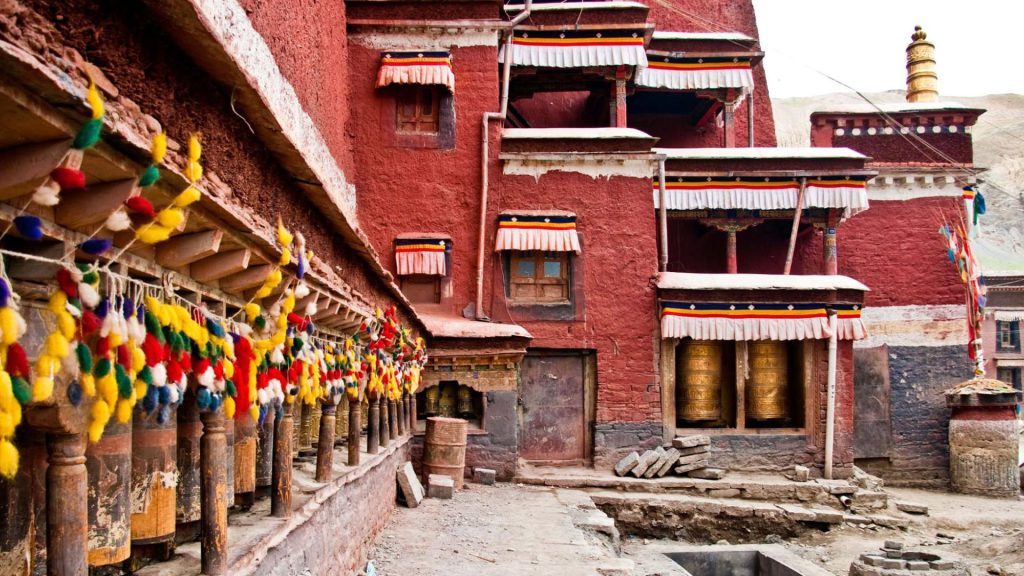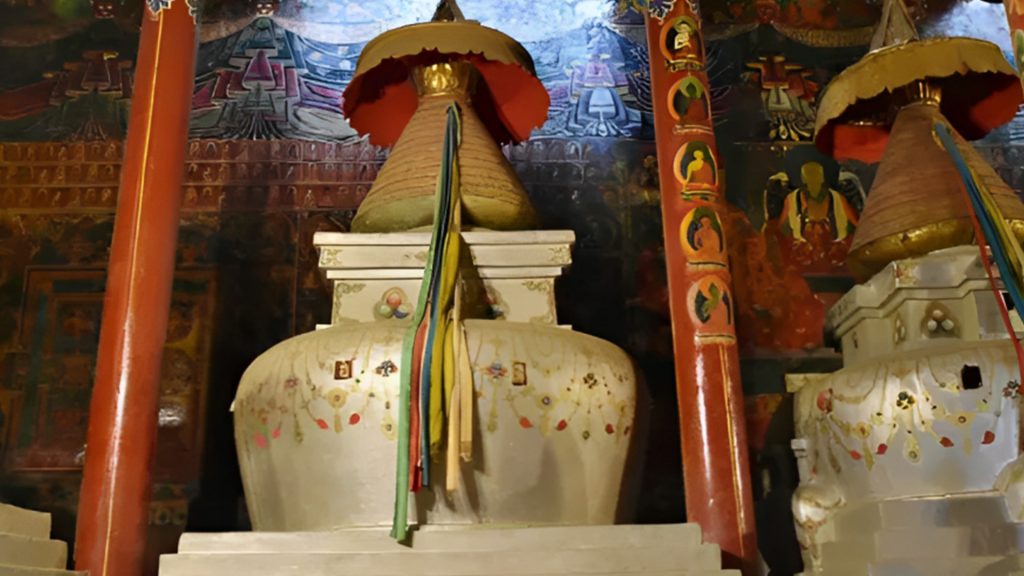In the heart of Tibet stands the Sakya Monastery, a silent witness to centuries gone by. This special place held a secret. For years, behind old walls, lay a library filled with ancient manuscripts. These papers tell tales from long ago, and they waited patiently, hidden from the world, to share their stories, until now.
Just Beyond The Wall
Many had walked the monastery’s halls, unaware of the treasures that lay just out of sight.

The old books and scrolls have seen empires rise and fall. They’ve captured the wisdom and adventures of people from ages past. They know about ancient kingdoms and great adventures. When discovered, it was like finding a map to another time.
Hidden Halls of History
The Sakya Monastery stands in the Tibet Autonomous Region, in the Southwestern part of the People’s Republic of China. Located around 300 miles west of Lhasa, Tibet, it serves as a center for worship and a vital historical site.

Sakya has always been a renowned seat for Tibetan Buddhism and scholarly pursuits. Unveiling a treasure trove of knowledge, the hidden Sakya Library in Tibet holds whispers of an ancient past.
A Stunning Monumental Architectural Building
The architectural grandeur of the Sakya Monastery represents both its spiritual and historical importance. Its cultural designs represent an intriguing visual narrative that narrates the stories of centuries of cultural and religious evolution. Let’s not forget about the monastery’s fortress-like walls and how it evokes a sense of strength and resilience.

The exterior of the Sakya Monastery is filled with structures adorned with vibrant colors, detailed murals, and elaborate details. These various structures not only contribute to the overall aesthetic appeal of the monastery but also significantly contribute to the deep religious symbolism rooted in the Buddhist tradition.
Home For Buddhist Teachings And Scholarship
Education has been an important aspect of the functions of the Sakya Monastery, which made it a distinguished center for Buddhist philosophy. The monastery stands as a citadel of learning, where the monks went through rigorous and comprehensive training and an extensive understanding of the scriptures.

The monastery over time has instilled knowledge through its educational programs allowing for continued Buddhist traditions while creating a new generation of monks who have been equipped to navigate the complexities of the world.
Beyond The Sacred Wall
Behind a secret wall, over 80,000 old writings waited. Why were they hidden? Perhaps to protect them from danger or to keep them safe for future generations.

Now, these precious papers give us a peek into Tibet’s history. They show us how people lived, what they believed, and how they dreamed. Thanks to the Sakya Monastery, a whole world has been brought back to life from long ago. Everyone can learn and be amazed by the wonders of the past.
The Spiritual And Religious Significance Of These Books
For centuries, the Sakya Monastery has been home to Buddhist teachings, practices, and various types of rituals. As a very important aspect of the Sakya tradition, the monastery has played the role of disseminating information about Buddhist philosophy, meditation techniques, and tantric practices.

Beyond human reasoning, and its physical presence the Sakya monastery holds profound spiritual meaning. It serves as a place of worship for thousands of people all over the world. They all travel from far places just to seek guidance and instructions from the sacred confines of the institution.
Manuscripts of Mysticism
The scale of this library is staggering. Picture traditional bookshelves stretching 200 feet and soaring to 33 feet, all packed with a whopping 84,000 books! Among these, there’s a standout: a single scripture that tips the scales at a massive 1,100 pounds, claiming the title of the heaviest in the world. Thanks to the region’s dry climate, the library also boasts a collection of delicate palm-leaf manuscripts, preserved in near-perfect condition.

Most of these texts are Buddhist scriptures, meticulously handwritten in various languages like Chinese, Tibetan, Mongolian, and Sanskrit. But the depth of this collection is vast. It isn’t limited to religious teachings; it expands into the realms of literature, history, philosophy, the stars above with astronomy, the logic of mathematics, the beauty of art, and even the practical wisdom of agriculture.
A Bridge Between Worlds
The Sakya Library serves as a tangible link between the ancient and the modern, the mystical and the empirical. Through its vast collection, it bridges different cultures and times, allowing for a dialog that transcends the ages.

The treasure trove of texts is more than a mere repository of knowledge; it’s a conversation held across the centuries, a discourse between the ancient scholars and the modern seeker. In the quiet halls, one could hear the whispers of the past mingling with the inquiries of the present, forming a continuum of human thought and spiritual quests.
What Does This Mean For The Future Of Mankind?
Imagine how beneficial the discovery of the hidden library and its contents will be for us humans. Its significance in terms of research and scholarship is immeasurable. It gives us an immense opportunity to understand Tibetan cultural traditions, history, religion, and philosophy better.

Researchers and scholars are eagerly anticipating the chance to study and translate these texts for the benefit of mankind. These texts will open the door to a wealth of knowledge, enriching our understanding of human history, spirituality, and cultural heritage contributing to the collective knowledge of mankind.
Preserved Pages of The Past
The Tibetan Academy of Social Sciences (TASS) took an interest in this vast collection, there was a move to bring this ancient knowledge into the digital age. The monastery began the monumental task of digitizing each page, ensuring that the wisdom of ages would be available for future generations.

So far TASS continues to examine and sort the library’s vast collection of books and palm-leaf manuscripts. All the books have been cataloged, and over 20% have been digitized. This library is not just a testament to the region’s rich history but a beacon of knowledge, shedding light on the mysticism and wisdom of bygone eras.
Golden Letters and Iron-bound Tales
Even before the revelation of the hidden library, this sacred place was already renowned for its treasure trove of ancient manuscripts. Sarat Chandra Das, an Indian scholar who immersed himself in Tibetan language and culture, ventured to Tibet in the late 19th century.

He painted a vivid picture of the Sakya Library in his records, telling of volumes inscribed in shimmering gold letters. Some manuscripts stretched to an impressive six feet in length and 18 inches wide. Others showcased intricate illuminated margins, while some were uniquely bound in sturdy iron. The craftsmanship was such that there were books adorned with images of a thousand Buddhas, adding to the library’s mystical allure.
Imperial Gifts and Spiritual Ties
But these manuscripts weren’t just crafted by any ordinary hands. Historians believe that these masterpieces were commissioned by none other than the emperor Kublai Khan himself. They were then graciously gifted to Phagpa Lama, the fifth leader of the Sakya School of Tibetan Buddhism.

This deep intertwining of religious devotion and imperial patronage adds another layer of intrigue to the Sakya Monastery’s vast collection, making it a beacon of history, art, and faith.
Echoes of Eternity
The Tibet Autonomous Region, the Sakya Monastery, stands tall, a sentinel of ancient wisdom and faith. Established in 1073, it proudly represents the teachings and traditions of the Sakya school of Tibetan Buddhism. Though the monastery has endured the wear of time, parts of its age-old architecture still stand, bearing witness to its storied past. Remarkably, what our eyes meet today took root in 1268, rising from the foundations of the original structures.

This monastery, which is in a place called Sagya County, has been fixed up many times. Over the years, some parts were damaged, but they were rebuilt. The building today, called Lhakhang Chempo, tells stories of the past, of times it was broken, and times it was fixed. It’s a reminder of the long journey of history.
Sakya’s Silent Stories
Back during the Cultural Revolution in China, a sad time came for Sakya. After an uprising in 1959 to keep the 14th Dalai Lama safe from harm, most of Sakya’s monks had to leave. Out of the hundreds that once were, by the end of that year, only 36 elderly monks stayed behind. The northern part of the monastery was destroyed during these tough times.

Thankfully, the southern half stood its ground, and the few remaining monks stood a testament to resilience: piles of manuscripts, stunning artworks, and books that have survived the ravages of time. In 2002, efforts were made to rebuild and restore the monastery, breathing new life into its ancient walls. Through all these challenges, Sakya’s silent stories continue to inspire, teaching us about the power of resilience and hope.
Conflicting Opinions And Theories
Just like every mysterious discovery, scholars, scientists, and archaeologists all have conflicting opinions. People have questioned the authenticity of the discovered manuscripts. Various Sources have expressed their concerns requesting credible reports to support their claims.

It would be unprofessional to put out information about the manuscript’s age, origin, and significance without proof. To date, the authenticity of the library’s content is still a debate and might be for a while.






